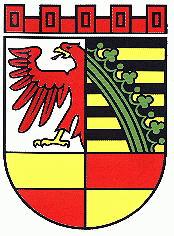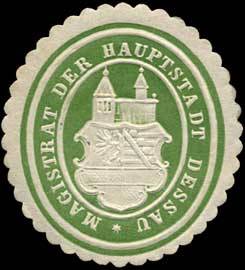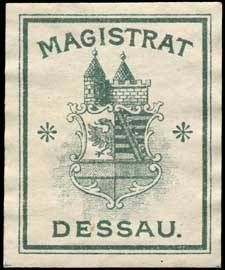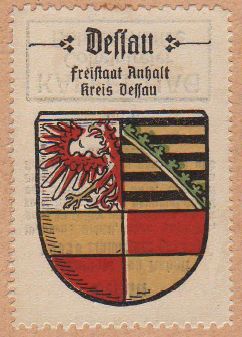Dessau: Difference between revisions
Knorrepoes (talk | contribs) No edit summary |
Knorrepoes (talk | contribs) m (Text replacement - "]] ====Origin/meaning====" to "]] ====Official blazon==== ====Origin/meaning====") |
||
| Line 10: | Line 10: | ||
[[File:dessau.jpg|center]] | [[File:dessau.jpg|center]] | ||
====Official blazon==== | |||
====Origin/meaning==== | ====Origin/meaning==== | ||
Revision as of 07:29, 2 January 2016
This page is part of the German heraldry portal |
Heraldry of the World |
|
German heraldry:
|
Selected collector's items from Germany:
|
DESSAU
State : Sachsen-Anhalt
Urban District (Kreisfreie Stadt) : Dessau
Additions : 1923 Alten, Großkühnau, Kleinkühnau, Törten, Ziebigk; 1930 Dellnau, Jonitz, Naundorf, Pötnitz, Scholitz (until 1933); 1935 Roßlau (until 1945); 1945 Mildensee, Waldersee; 1950 Kochstedt 1952 Mosigkau; 1994 Kleutsch, Sollnitz; 2005 Brambach, Rodleben
Incorporated into : 2007 Dessau-Roßlau
Official blazon
Origin/meaning
The arms were officially granted on July 4, 1994 and previously in 1951.
The arms show in the upper part the arms of the Princes of Anhalt and in the lower part the arms of he Lords of Waldeser. The city was part of Sachsen-Anhalt and the Lords of Waldeser had their castle close to the city. The city used only the arms of Sachsen-Anhalt in the seals dating from the 16th century. The mural crown indicates the freedom and strength of the city.
In 1933 the city added a small escutcheon with the local church, as the oldest seals of the city showed the church. These arms, which were never officially granted, were in use until 1951, see image below.
| Seal from around 1900 |
Seal from around 1900 |
| The old arms in the Kaffee Hag albums +/- 1925 |
The arms with the inescutcheon in the Kaffee Hag albums mid 1930s |
Contact and Support
Partners:
Your logo here ?
Contact us
© since 1995, Heraldry of the World, Ralf Hartemink 
Index of the site
Literature : Stadler, 1964-1971, 8 volumes; Hupp, 1920s; Papendieck, 1996.
















